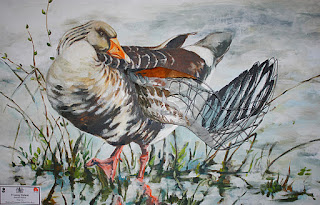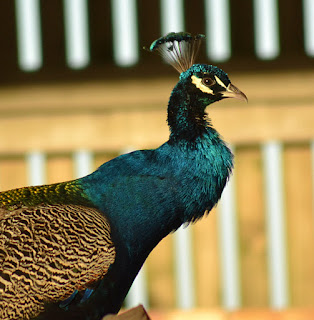I decided the day before I left to make the trip to the RSPB reserve at Old Hall Marshes to twitch the long-staying Red-breasted Goose. The trip to the reserve involved taking the train into London before cycling between Euston and Liverpool street and then making a second train trip out of London (past the construction site of the Olympic Stadium) to Kelvedon, the closest train station 9 miles from the reserve. The rest of the trip took another hour worth of cycling but the cost and effort was definitely worth it.
RSPB OLD HALL MARSHES
As soon as I pulled into the reserve car park the familiar soon of hundreds of Brent Geese honking as they came in to land was immediately obvious. I rushed to the scene just in time to see
500+ dark-bellied Brent Geese recently alighted in the improved pastures about 1/4 mile NE of Old Hall Marsh Farm. Despite scanning the flock thoroughly the Red-breasted Goose still remained elusive until smaller flocks gradually trickled in and amongst them I glimpsed the characteristic Red breast of my first ever
RED-BREASTED GOOSE (a 1st. winter) (a life tick). It alighted near the center of the already present flock of dark-bellied Brent Geese and showed amazingly. I decided to follow the footpath further around the reserve to obtain a better view and from the sea wall it showed very well allowing me to take some record digi-scope shots.
My first view of the 1st. win. RED-BREASTED GOOSE
try and find the bird!
This was a brilliant start to the day as I still had plenty of time to take the long route around the reserves perimeter. I also had the pleasure of meeting Alan, a university lecturer from the Open University of London, we decide to make the round trip together and managed to clock up dozens of interesting birds. Just east of the Brent Geese a flock of
100+ Wigeon were also feeding in the improved fields and dozens of
Redshank were present feeding in the Salcott Channel. Further east,
100's of Dunlin were feeding in the muddy margins of the channel along with a large number of Teal.
2 juvenile Peregrines were also a nice surprise as the alighted on the wooden posts in the center of the channel as was the impressive sight of
8 RED-BREASTED MERGANSER (4♂, 4♀) (a year tick) as well as
3 Goldeneye (1♂, 2♀) (a year tick). We were accompanied by the almost constant sight of
Skylarks taking off from the sea wall grass slopes and closer to Quarters Spit I found a
1st. win. MERLIN perched on a wooden post along the edge of the wall. It soon took flight and made a wide circuit around the marsh, pelting low over the water in the classic Merlin flight pattern followed by the impressive sight of
1-2 SHORT-EARED OWLS come over the marsh.
Marsh Harriers were also on view for most of the time, juveniles being the most frequent and from the end of the peninsula we noted a small flock of
Grey Plover,
Great Black-backed Gulls,
Herring Gulls and
Black-headed Gulls followed by a brief view of a
Grey Seal poking its head above the water with prey in its mouth. As I was walking along the sea wall another or possibly the same
SHORT-EARED OWL erupted from the grassy bank only 2 meters from were I was stood before heading of over the marsh a little out to sea and then returning down Salcott Channel. Better still Alan picked up on
3 win. RED-THROATED DIVERS (a year tick) shortly before they took flight and headed out to sea. In addition to the previous record of 8 Red-breasted Mergansers an additional
13 RED-BREASTED MERGANSERS were noted in the North and Virley Channel and
6 Eiders (1♂, 5♀) (a year tick) were sat on the end of the Great Cob Island sand bank.
Tollesbury Fleet
Joyce's Head Fleet
On our way back along the South side of the Peninsula,
3+ Little Egrets were of note as was the sight of a possible WATER PIPIT on the edge of the concrete sea wall. There were also an impressive number of
Dunlin and
Grey Plovers resting on the exposed marsh (waiting for the next low tide). We also found a single Hare washing itself and
3 win. SPOTTED REDSHANKS (a year tick) in the Irongate Lagoon. Another birder also kindly notified us of a
immature colour ringed SPOONBILL (a year tick) which we later found sieving the marshy waters for invertebrates. It was an impressive bird and thoroughly white, a little bedraggled and the lower mandible appeared translucent red at times when the light shone through.
immature Spoonbill
light shining through the translucent red upper and lower mandible
Also in the Irongate Lagoon we heard a CETTI'S WARBLER calling from deep within the reads and a small group of BEARDED TITS were also calling, but unfortunately didn't show themselves.
Other birds of note around the reserve included a
Green Woodpecker climbing the pole of an owl nest box and dozens of
Reed Buntings on the improved marshes,
1 Linnet,
1♂ Stonechat approaching summer plumage,
64+ Black-tailed Godwit and dozens of
Curlew (the later two amongst the Brent Geese). Ducks included
Shoveler,
Tufted Duck,
Mallard,
Wigeon,
Teal and
Pochard mainly found in the Irongate Lagoon. After departing with Alan I decided to go back to the huge flock of Brent Geese in the improved fields that had just arrived north of Old Hall Creek. I was once again glad to re-find the Red-breasted Goose amongst the masses and took a few last digi-scope shots.
Red-breasted Goose
had its head down for much of the time as it was feeding almost continuously, it was also less active than the Brent Geese and tended to remain in a small area instead of noisily running around and squabbling.
Next, I decided to retrace my steps back along the sea wall to the headland at Tollesbury Fleet. It was here that I picked up on a
BARN OWL perched near Pennyhole Fleet, I tried to take some digi-scope shots but it soon took flight and began quartering the fields, after less than a minute of watching it made a beeline for where I was standing, still making occasional swoops into the grass but it soon diverted its attention to me, standing on the top of the sea wall. It was clear that it had noticed me and deliberately began flying towards me, it then approached even closer as it flew at head height up the sea wall and made an amazingly close bank less than two feet from my head, whilst I stood in shock and awe! It glared into my eyes with its dark iris as its silent wing beats almost scrapped my face I was certain this was a moment I shall never forget!
Nothing could have topped such an amazing sight but as I was still in high spirits I stopped to search the reedbeds once again for the Bearded Tits with another local observer. Fortunately, our efforts paid off as
3♂ BEARDED TITS (a life tick) came into view (not including 2 other birds calling from within the reeds) as they fed on the tops of the reed heads, what a way to end the day!
Bearded Tits


























































